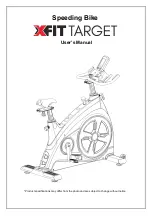
1
Nautilus NS00X
SEATED ShOULDEr prESS
— Shoulder Abduction (and elbow extension)
ShOULDEr EXErCISES
STArT
FINISh
Muscles worked:
This exercise emphasizes the
side shoulder muscles (middle deltoids), the
top muscles of the rotator cuff (supraspinatus)
and the upper trapezius muscles.
Starting position:
• Stand facing perpendicular to the low pulley
station, grasp the handle with your farthest
hand, palm facing the machine.
• Place your opposite hand on your hip.
• Feet should be spaced shoulder width.
Motion:
• Raise your arm so that it is level with the
floor, do not go beyond this range.
• Keep your elbow slightly bend during the
movement.
• Slowly lower your arm to the starting
position without relaxing or resting the
weight.
Key points:
• Do not twist your trunk during this
movement.
• Do not bend your elbow during the exercise.
• If you are unable to reach a full range of
motion, lower the weight.
LATErAL ShOULDEr rAISE
— Shoulder Abduction (and elbow extension)
Muscles worked:
This exercise emphasizes
the front shoulder muscles (anterior deltoid,
a portion of the middle deltoid) and the
triceps, which are located on the back of the
upper arm.
Starting position:
• In the seated position, grasp the upper
handles, and bend your elbows until your
hands are near your chest. Rotate your upper
arms away from your torso so that your
elbows are pointing outward to each side and
your palms are facing down.
• Adjust the seat back tilt forward to the fourth
or fifth incline position depending on your
comfort level.
• Hands are positioned just outside of your
upper chest, with palms facing down and
wrists straight.
Motion:
• Slowly move your elbows outward,
simultaneously bending your arms so that
your forearms remain parallel to each other
and the hands remain over the elbows
throughout the movement.
• Stop when your upper arms are
approximately straight out to the sides (your
elbows will be level with your shoulders or
very slightly below).
Key points:
• Limit and control the range of motion so
that your elbows travel only slightly behind
your shoulders — if at all.
• For normal pressing/pushing patterns of
movement you may choose to allow the
shoulder blades to “float” forward and
backward naturally with the arm movement,
or for increased pec involvement you may
keep the shoulder blades “pinched” together
throughout both the upward and downward
movements.
STArT
FINISh













































